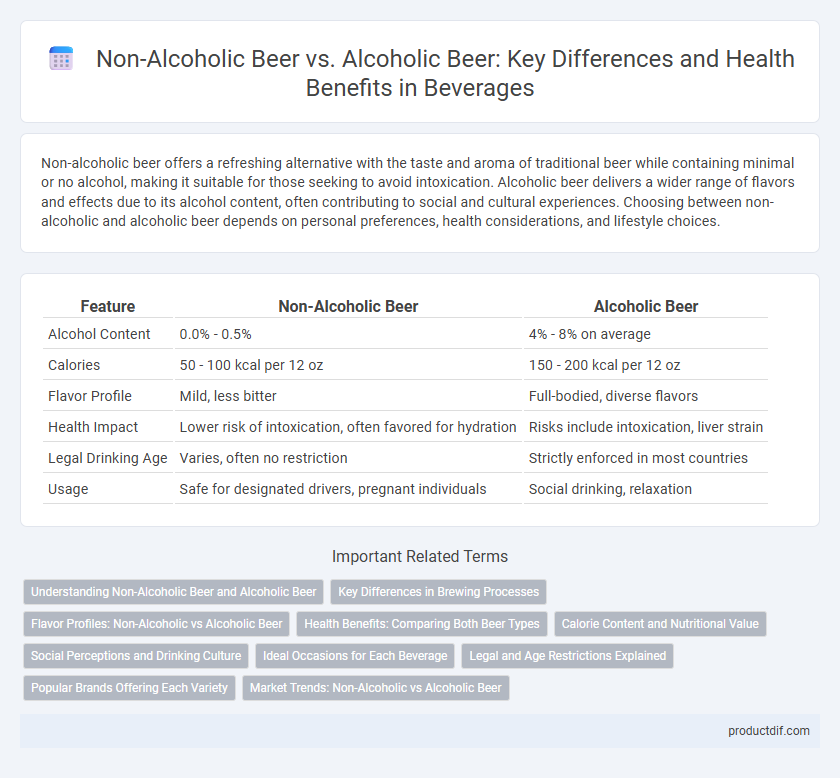Non-alcoholic beer offers a refreshing alternative with the taste and aroma of traditional beer while containing minimal or no alcohol, making it suitable for those seeking to avoid intoxication. Alcoholic beer delivers a wider range of flavors and effects due to its alcohol content, often contributing to social and cultural experiences. Choosing between non-alcoholic and alcoholic beer depends on personal preferences, health considerations, and lifestyle choices.
Table of Comparison
| Feature | Non-Alcoholic Beer | Alcoholic Beer |
|---|---|---|
| Alcohol Content | 0.0% - 0.5% | 4% - 8% on average |
| Calories | 50 - 100 kcal per 12 oz | 150 - 200 kcal per 12 oz |
| Flavor Profile | Mild, less bitter | Full-bodied, diverse flavors |
| Health Impact | Lower risk of intoxication, often favored for hydration | Risks include intoxication, liver strain |
| Legal Drinking Age | Varies, often no restriction | Strictly enforced in most countries |
| Usage | Safe for designated drivers, pregnant individuals | Social drinking, relaxation |
Understanding Non-Alcoholic Beer and Alcoholic Beer
Non-alcoholic beer typically contains less than 0.5% alcohol by volume (ABV), offering a similar flavor profile to traditional alcoholic beer while minimizing intoxicating effects. Alcoholic beer usually ranges from 4% to 8% ABV, providing a wider variety of styles and a more pronounced impact on the body and mind. Understanding the differences in fermentation processes, alcohol content, and taste characteristics is essential for consumers choosing between non-alcoholic and alcoholic beer options.
Key Differences in Brewing Processes
Non-alcoholic beer is brewed using similar ingredients as alcoholic beer, but with a critical difference in fermentation control to limit alcohol content, often achieved by early fermentation cessation or alcohol removal techniques such as vacuum distillation or reverse osmosis. Alcoholic beer undergoes full fermentation, allowing yeast to fully convert sugars into alcohol and carbon dioxide, resulting in typical alcohol content ranging from 4% to 8% ABV. The brewing process for non-alcoholic beer requires precise temperature and time management to retain flavor compounds while minimizing alcohol formation, distinguishing it fundamentally from traditional alcoholic beer production.
Flavor Profiles: Non-Alcoholic vs Alcoholic Beer
Non-alcoholic beer offers a similar malt and hop character as alcoholic beer but often with a lighter body and reduced bitterness due to lower alcohol content. Alcoholic beer provides a wider range of complex flavor profiles, including roasted, fruity, and spicy notes influenced by yeast fermentation and maturation processes. The presence of alcohol enhances mouthfeel and aroma intensity, contributing to a fuller sensory experience compared to non-alcoholic alternatives.
Health Benefits: Comparing Both Beer Types
Non-alcoholic beer contains fewer calories and significantly less alcohol, reducing the risk of liver damage, high blood pressure, and addiction compared to alcoholic beer. It also retains essential vitamins and antioxidants found in traditional beer, supporting cardiovascular health without the negative effects of ethanol. Alcoholic beer, while offering moderate heart benefits and increased HDL cholesterol, poses higher risks for liver disease and impaired cognitive function with excessive consumption.
Calorie Content and Nutritional Value
Non-alcoholic beer typically contains fewer calories than alcoholic beer, averaging around 50-100 calories per 12-ounce serving compared to 150-200 calories in regular beer. Nutritionally, non-alcoholic beer often provides small amounts of vitamins and minerals such as B vitamins, potassium, and antioxidants while containing minimal alcohol, which reduces its impact on liver health and metabolism. Alcoholic beer, while offering some nutritional benefits like trace minerals, generally contributes to higher calorie intake due to its alcohol content, which can affect weight management and overall nutritional balance.
Social Perceptions and Drinking Culture
Non-alcoholic beer is increasingly embraced in social settings as a healthier alternative that allows inclusion for designated drivers and those abstaining from alcohol. Alcoholic beer remains deeply rooted in traditional drinking culture, often associated with social bonding, celebrations, and rituals. Shifts in social perceptions reflect growing acceptance of non-alcoholic options, challenging conventional norms while maintaining the cultural significance of beer consumption.
Ideal Occasions for Each Beverage
Non-alcoholic beer suits occasions like office gatherings, designated driving events, and health-conscious social moments where alcohol intake is avoided. Alcoholic beer is ideal for celebrations, casual hangouts, and sporting events where social drinking enhances the experience. Choosing between the two depends on social context, personal preference, and the need for alcohol moderation.
Legal and Age Restrictions Explained
Non-alcoholic beer typically contains less than 0.5% alcohol by volume, allowing it to be legally sold to individuals under the drinking age in many regions, though regulations vary widely by country and state. Alcoholic beer is strictly regulated with age restrictions that generally prohibit sales to anyone under 18 or 21 years old, depending on local laws. Understanding these legal distinctions is crucial for retailers and consumers to ensure compliance and avoid penalties related to underage sales.
Popular Brands Offering Each Variety
Non-alcoholic beer options from popular brands include Heineken 0.0, Budweiser Zero, and Clausthaler Dry-Hopped, catering to consumers seeking the beer experience without alcohol. Leading alcoholic beer brands like Budweiser, Corona, and Guinness dominate the market with a wide range of flavors and alcohol content. Both categories emphasize quality and taste, with innovation driving new releases to satisfy evolving consumer preferences.
Market Trends: Non-Alcoholic vs Alcoholic Beer
The global non-alcoholic beer market is experiencing rapid growth, projected to reach $25 billion by 2028, driven by increasing health-conscious consumer preferences and stricter alcohol regulations. In contrast, the alcoholic beer segment faces stagnating sales in mature markets but remains dominant with a market value exceeding $600 billion globally. Shifts in consumer behavior, especially among Millennials and Gen Z, fuel demand for low- and no-alcohol options, prompting major breweries to innovate and expand non-alcoholic product lines.
Non-Alcoholic Beer vs Alcoholic Beer Infographic

 productdif.com
productdif.com